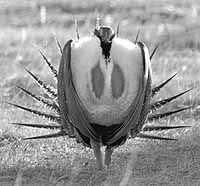| A strutting male sage grouse fans his pointed tail feathers and puffs his chest. |
The strutting ground north of Price is open for the free viewing of sage grouse will be open Saturday, April 17 from 6:30 a.m. to 8 a.m.
According to Brent Stettler of the Division of Wildlife Resources, the best viewing opportunities occur at the break of dawn. By sunrise, many birds will either stop strutting or leave the ground, so plan to come early Stettler commented.
The strutting ground is located along the Emma Park Road. Drive up Price Canyon and turn right at the Castle Gate Power Plant. Travel U.S. 191 to the Bamberger Monument and follow the DWR’s signs to the strutting ground.
During March and April every year, sage grouse congregate at strutting grounds or leks to perform the species’ mating ritual. Male or cock sage grouse advertise their suitability as mates by putting on an elaborate show. They fan their pointed tail feathers, puff out their white chest feathers and inflate gular sacs, which look like yellowish balls (half- spheres) protruding from their chests.
Cocks emit a “blooping” or “bubbling” sound as they prance around, trying to attract mates and frighten rivals. The most dominant males occupy the best real estate on the strutting ground, which is the center of activity. Turf wars break out frequently, as one male struts too closely to another. Competing males will batter each other with a flurry of wing beats and foot kicks, until one of the two retreats. This activity goes on for about a month, but peaks in early April.
Hens generally appear around the edge of the strutting ground in late March. They spend their time feeding on the spring green-up, and appear to ignore all the fanfare put on in their behalf. As hens walk around the lek, strutting males will sometimes follow them in an attempt to attract their attention. When an individual hen senses she is ready, she will posture in front of a male, signaling him that the time is right.
She submits to breeding only once with a single male. After mating, she flies from the strutting ground to build a nest. Unless the nest fails, she won’t return to the strutting ground until the following spring.
It is recommended that spectators dress warmly and bring binoculars, although binoculars and spotting scopes will be on-hand for public use.
For more information, contact Stettler at 636-0266.

